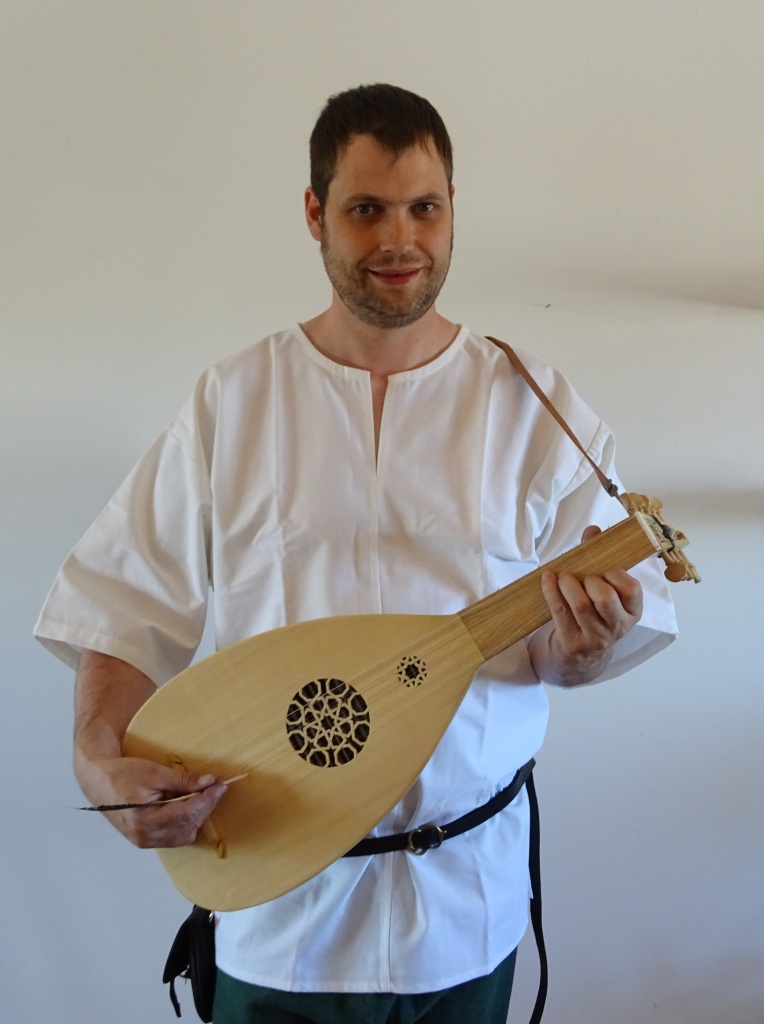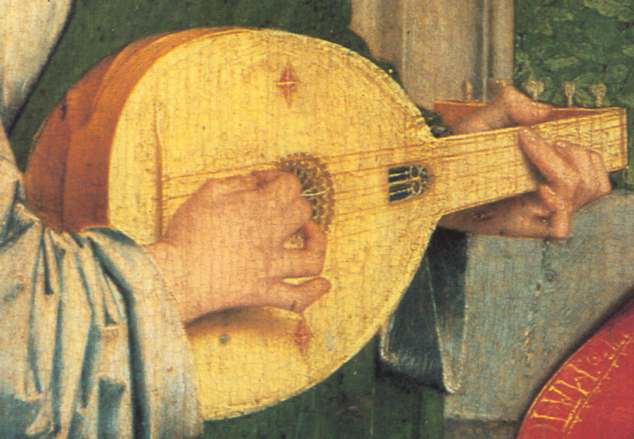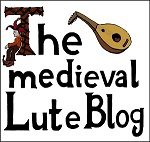Posture
If you consider the lute’s weight (which is much lighter than a modern guitar), standing whilst playing seems to be a doable way of performing, e.g. in reenactment situations, especially if you play on a medieval market or some other medieval event, even for a longer period.

If you just want to sit relaxed and play only for yourself, you don’t even need a shoulder strap. You can simply handle your lute as if you were playing a guitar in sitting position.
Playing technique
Depending on the situation of a given performance, you might want to select between two options of playing techniques:
- Playing with your fingertips, which delivers a slightly softer and calmer sound
- Playing with a Risha, which is a plectrum for the arabic lute, or
- Playing with a quill, e.g. a feather, which can create a very loud and present sound if required for the audience.
Historically, except quills, also bone, horn and antler had frequently been used as they were available most of the time. Sometimes, the lute performer would use a piece of gut string tied around his index finger in order to play.
If you use a feather, horn, bone, antler or a piece of wood, however, please make sure you are not scratching it over the top of your lute! I do recommend to only use it at all if a) you have a beginner instrument and don’t mind a few scratches on the soundboard, or b) you are advanced enough in your playing technique that not too much can go wrong!
Also, you can, surely, begin with a modern guitar plectrum, if none of those options seem like a good start to you!


In terms of correctness we should mention the handholding position both of the plucking-hand as well as the pressing hand:
Take the two following iconographic sources as an orientation:

Source: Unknown

Source: David van Edwards
https://www.vanedwards.co.uk/2.htm
The plucking hand (in this case the right hand) is placed parallel to the bridge and does not cover the soundhole at all. Many mistakes stem from plucking to harshly or, if you are using any form of quill, it is important to use a propper rightangle in relation to the strings. If you are using a risha or a feather you need to only apply the very tip of it. Especially in the case of the more flexible risha you have the problem that you often slam it against the thin soundboard, which produces a loud and disturbing sound. If you apply the feather in the wrong way, you have a loud scratching sound whilst performing! I therefore recommend to work a) as smooth and b) as slowly as possible especially in the beginning stages of your practice. When you are using a quill you are quicker on the course or two courses that you deal with, anyhow.
The pressing hand (in this case the left hand) is placed in such a way that the player is able to cover four frets at the same time, hence he or she must hold the hand with the fingertips pointing upwards perfectly, otherwise this would not be possible. We also see the thumb on the top of the neck – something which is rather unusual in the guitar world, but is possible in the medieval lute, because the neck is thin enough to do so comfortably. Nonetheless, I do not recommend to do it, because on the upper side of the neck of a medieval lute you usually have the ends of the knotted frets. On this side the most common mistake is the so called “fret buzz“. Also, please keep in mind that you have to deal with double-strings (courses) which make it even more necessary to press a) with enough pressure and b) using the fingertips carefully on the fretboard to avoid any type of disorders.
When it comes to learning “characteristic” plectrum – techniques of plucked medieval instruments, such as the medieval lute, the citole or the medieval gittern, the following pictures might be helpful as well in terms of the handling:
The first technique illustrated below indicates the use of a feather as a plectrum:




The second technique represents the “loop-end” technique, as alluded in the second iconographic source above. In this technique, a gut string was used, shortened and then bowed to a loop in order to use as a plectrum – which works suprisingly good and sounds somewhat nice! In this particular example, the G-string of a guitar has been used:





If you are unsure whether this works for you or not, you can also check any instruction book or manual regarding the playing technique of the Oud (modern Oriental lute) as performers use nearly the same basic techniques to this day!
